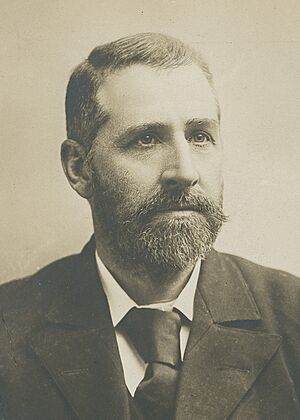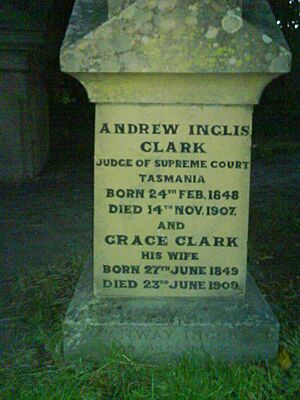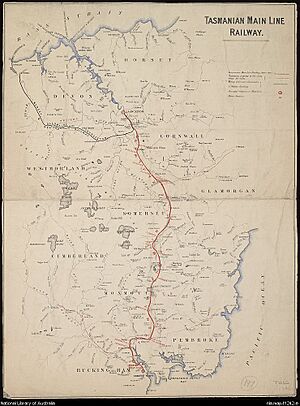Andrew Inglis Clark facts for kids
Quick facts for kids
Andrew Inglis Clark
|
|
|---|---|
 |
|
| Judge of the Tasmanian Supreme Court | |
| In office 1 June 1898 – 14 November 1907 Serving with John McIntyre
|
|
| Chief Justice | John Stokell Dodds |
| Preceded by | Robert Patten Adams |
| Succeeded by | Herbert Nicholls |
| Member of the Federal Council of Australasia | |
|
Appointed
|
|
| In office 3 January 1888 – 1 January 1901 Serving with
|
|
| Monarch | Victoria |
| Preceded by | Position established |
| 16th Leader of the Opposition in Tasmania | |
| In office November 1897 – May 1898 |
|
| Premier | Edward Braddon |
| Preceded by | Elliott Lewis |
| Succeeded by | Stafford Bird |
| 13th Attorney-General of Tasmania | |
| In office 14 April 1894 – 23 October 1897 |
|
| Premier | Edward Braddon |
| Preceded by | Elliott Lewis |
| Succeeded by | Don Urquhart |
| In office 29 March 1887 – 17 August 1892 |
|
| Premier | Philip Fysh |
| Preceded by | Richard Lucas |
| Succeeded by | Elliott Lewis |
| Member of the Tasmanian House of Assembly | |
| In office 20 January 1897 – 17 June 1898 Serving with
|
|
| Preceded by | Electorate established |
| Succeeded by | Charles Hoggins |
| Constituency | Hobart |
| In office 4 March 1887 – 20 January 1897 Serving with
|
|
| Preceded by | John Stokell Dodds |
| Succeeded by | Robert Patterson (1903) |
| Constituency | South Hobart |
| In office 26 July 1878 – 29 May 1882 |
|
| Preceded by | Charles Hamilton Bromby |
| Succeeded by | William Henry Archer |
| Constituency | Norfolk Plains |
| Personal details | |
| Born |
Andrew Inglis Clark
24 February 1848 Hobart, Van Diemen's Land |
| Died | 14 November 1907 (aged 59) Hobart, Tasmania, Australia |
| Resting place | Queenborough Cemetery, Sandy Bay, Hobart, Tasmania |
| Citizenship | |
| Political party | Independent |
| Spouse |
Grace Paterson Ross
(m. 1878) |
| Children | 8 |
| Parent |
|
| Residences | Rosebank, Battery Point, Hobart, Tasmania |
| Education | Hobart High School |
| Alma mater | Christ's College, Hobart (AA) |
| Occupation |
|
| Known for |
|
Andrew Inglis Clark (born 24 February 1848 – died 14 November 1907) was an important figure in Australia's history. He helped create the Australian Constitution, which is like the rulebook for our country. He was also an engineer, a lawyer, a politician, and a judge.
Clark first trained as an engineer. But he later became a lawyer to fight for social causes he cared about. He worked as the Attorney-General (the government's chief legal advisor) and briefly as the Opposition Leader in Tasmania. Later, he became a Senior Justice of the Supreme Court of Tasmania. Even though he was a top expert on the Australian Constitution, he was never appointed to Australia's highest court.
He made the Hare-Clark voting system popular and brought it to Tasmania. This system helps make elections fairer. Clark was also a writer and a Vice-Chancellor of the University of Tasmania. He was always a progressive thinker. He supported workers' rights to form unions, and he believed everyone should have the right to vote, including women. He also fought for fair trials. These ideas were very new and even seen as radical in the 1880s.
Clark was known for his strong beliefs in independence and fairness. He fought for an independent legal system and for more people to have the right to vote. He also wanted modern universities and a strong, independent Australia. He was also a loving family man. He was known for always having time for his children.
The Australian federal area called the Division of Clark is named after him.
Contents
Early Life and Family
Andrew Inglis Clark was born in Hobart, Tasmania. His father, Alexander Clark, was a Scottish engineer. Andrew went to Hobart High School. After school, he trained in his family's engineering business. He became a qualified engineer and later managed the business. His father's company was very successful, building things like flour mills and coal mines.
Clark grew up during the 1860s. At this time, the American Civil War and the fight to end slavery were big topics, even in Tasmania. Slavery, in the form of sending convicts to Tasmania, had only ended in 1853. Clark was very interested in American ideas. He was even moved to tears when talking about slavery later in his life.
In 1872, Clark decided to study law instead of engineering. He became a lawyer in 1877. As a child, Clark attended a Baptist Sunday School. Later, he joined a Unitarian church. This led him to meet important American Unitarians, like Oliver Wendell Holmes Jr. This friendship greatly influenced Clark's ideas, especially his draft of the Australian Constitution.
From a young age, Clark cared deeply about justice and freedom. He joined clubs where people debated social issues. He was a strong supporter of republican ideas, believing in a country led by its citizens, not a king or queen. He was inspired by Italian leaders who fought for freedom.
In 1878, he married Grace Paterson Ross. They had eight children:
- Esma (born 1878)
- Alexander (born 1879), who became a marine engineer
- Andrew (born 1882), who became a judge like his father
- Conway (born 1883), an architect
- Wendell (born 1885), a doctor
- Melvyn (born 1886)
- Carrel (born 1888), who worked for the Tasmanian government
- Ethel (born 1889)
Clark and Grace married quietly in Melbourne. This was unusual for such well-known families at the time.
Political Journey
In 1878, Clark ran for election to the Tasmanian Parliament. Some people thought his ideas were too extreme. Newspapers even called him a "communist." But he was elected without anyone running against him for the area of Norfolk Plains.
Clark started the Southern Tasmania Political Reform Association. This group wanted fairer voting rules and fixed terms for parliament. As a politician, Clark was seen as very progressive. He was one of the few members who successfully introduced new laws as a regular member of parliament. He helped change laws about criminal trials and customs.
Clark lost his election in 1882. He tried again in 1884 and 1886 but didn't win. In 1887, he was re-elected for East Hobart. Then, from 1888, he represented South Hobart until 1897. After that, he was the member for Hobart until he became a judge in 1898.
Serving as Attorney-General
In March 1888, Clark became the Attorney-General in Philip Fysh's government. This meant he was the government's main legal advisor. He was in charge of introducing many new laws in parliament. His main goal was to reduce the power of wealthy landowners in Tasmanian politics.
He helped pass many important laws:
- Making trade unions legal.
- Paying politicians a salary.
- Preventing cruelty to animals.
- Protecting children from neglect and abuse.
He also tried to introduce a land tax and universal voting rights (including for women), but these attempts were not successful at the time.
Clark was a very important Attorney-General in the 1800s. He was skilled at writing laws, which helped him update and simplify many areas of the law. He introduced 228 bills to parliament. His most famous achievement was bringing in proportional representation, known as the Hare-Clark system, for elections.
Clark also played a key role in a big issue about the Tasmanian Main Line Railway. This railway connected Hobart and Launceston. There were arguments between the railway company and the government over payments. Clark, being both an engineer and a lawyer, understood the problem well. As Attorney-General, he was the government's chief negotiator.
In 1889, a court ruled that the government owed the company money. Clark went to England in 1890 to argue the case. He was a great negotiator. He settled the case by arranging for the government to buy the railway company.
In 1891, Clark returned to Tasmania through the United States. This trip was very important. He met Oliver Wendell Holmes Jr., a fellow Unitarian, and they became lifelong friends. The people and ideas he encountered in America greatly shaped his views on how governments should be set up. This trip also led to the word "commonwealth" being used to describe Australia.
In 1892, Clark's time as Attorney-General ended when the government changed. But when Sir Edward Braddon formed a new government in 1894, Clark became Attorney-General again. He was given the title 'Honourable' for life. He left this role in 1897 and became the Leader of the Opposition. In 1898, he left politics to become a Justice of the Supreme Court of Tasmania.
Clark and Australian Federation
Clark had a complex role in the creation of Australia as a united country (Federation). He was a delegate at the 1891 National Australasian Convention, which drafted an early version of the constitution.
However, he did not attend the 1897 Australian Federal Convention. He also didn't strongly support the Federation movement in the campaigns leading up to the vote. A week before the 1898 vote on Federation, he stated that he would not tell anyone how to vote.
Hare–Clark Electoral System
In 1896, after several tries, Clark successfully introduced a system of proportional representation in the Tasmanian Parliament. This system, known as Hare–Clark, was first used in Hobart and Launceston for a trial period. It was renewed each year until 1902. Clark passed away in 1907. The Hare–Clark system became permanent in Tasmania shortly after his death and was first used across the whole state in the general election in April 1909.
Early Legal Career
Clark became a lawyer in 1877. He quickly became known as a good lawyer, especially in criminal cases. He also built a large practice in civil and business law. He continued to practice law even when he was not in parliament. He was known for being generous and not charging very high fees. In 1887, he started a law firm with Matthew Wilkes Simmons.
His work as a private lawyer gave him a wide understanding of the law. This helped him greatly when he became a judge. Clark knew a lot about all areas of law, but he was especially good at constitutional law.
Clark was not always in good health. He was described as "small, thin, and nervous." He passed away at his home 'Rosebank' in Battery Point on 14 November 1907. He is buried in the old Queenborough Cemetery in Sandy Bay.
Images for kids
See Also
- Hare–Clark electoral system
- Constitution of Australia
- Federation of Australia




